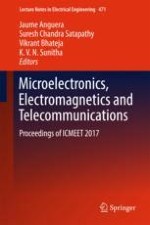2018 | Buch
Microelectronics, Electromagnetics and Telecommunications
Proceedings of ICMEET 2017
herausgegeben von: Dr. Jaume Anguera, Dr. Suresh Chandra Satapathy, Prof. Dr. Vikrant Bhateja, Dr. K.V.N. Sunitha
Verlag: Springer Singapore
Buchreihe : Lecture Notes in Electrical Engineering
